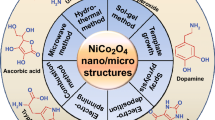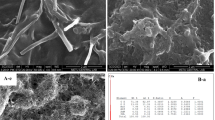Abstract
A tyrosinase (Tyr) biosensor has been constructed by immobilizing tyrosinase on the surface of Mg–Al–CO3 hydrotalcite-like compound film (HTLc) modified glassy carbon electrode (GCE) for the determination of polyphenols. The negatively charged tyrosinase was adsorbed firmly on the surface of a positively charged HTLc/GCE by electrostatic interactions and retained its activity to a great degree. The modified electrode was characterized by cyclic voltammetry and AC impedance spectra. Polyphenols were determined by a direct reduction of biocatalytically generated quinone species. The different parameters, including pH, temperature, and enzyme loading were investigated and optimized. Under the optimum conditions, Tyr/HTLc electrode gave a linear response range of 3–300, 0.888–444, and 0.066–396 μM with a detection limit (S/N = 3) of 0.1, 0.05, and 0.003 μM for catechol, caffeic acid, and quercetin, respectively. In addition, the repeatability and stability of the enzyme electrode were estimated. Total polyphenol contents of real samples were also determined to study the potential applicability of the Tyr/HTLc/GCE biosensor.






Similar content being viewed by others
References
Mila I, Scalbert A, Expert D (1996) Iron withholding by plant polyphenols and resistance to pathogens and rots. Phytochemistry 42:1551–1555
Mello LD, Sotomayor MDPT, Kubota LT (2003) HRP-based amperometric biosensor for the polyphenols determination in vegetables extract. Sens Actuators B: Chem 96:636–645
Madhan B, Subramanian V, Raghava Rao J, Unni Nair B, Ramasami T (2005) Stabilization of collagen using plant polyphenol: role of catechin. Int J Biol Macromol 37:47–53
Cooray HC, Janvilisri T, van Veen HW, Hladky SB, Barrand MA (2004) Interaction of the breast cancer resistance protein with plant polyphenols. Biochem Biophys Res Commun 317:269–275
Mossion AC, Balayssac S, Gilard V, Martino MM, Gautier MP, Behra P (2010) Interaction mechanisms between caffeine and polyphenols in infusions of Camellia sinensis leaves. Food Chem 119:173–181
Chang KY (1973) Interaction of phenol with the polysaccharide of bacterial cell wall. Biochem Biophys Res Commun 51:900–906
Gupta KC, Sutar AK (2007) Polymer anchored Schiff base complexes of transition metal ions and their catalytic activities in oxidation of phenol. J Mol Catal A: Chem 272:64–74
Gladine C, Morand C, Rock E, Bauchart D, Durand D (2007) Plant extracts rich in polyphenols (PERP) are efficient antioxidants to prevent lipoperoxidation in plasma lipids from animals fed n − 3 PUFA supplemented diets. Anim Feed Sci Tech 136:281–296
Kamatou GPP, Viljoen AM, Steenkamp P (2010) Antioxidant, antiinflammatory activities and HPLC analysis of South African Salvia species. Food Chem 119:684–688
Ferguson LR (2001) Role of plant polyphenols in genomic stability. Mutat Res 475:89–111
Ivanova E, Toshkova R, Serkedjieva J (2005) A plant polyphenol-rich extract restores the suppressed functions of phagocytes in influenza virus-infected mice. Microbes Infect 7:391–398
Kuroda Y, Hara Y (1999) Antimutagenic and anticarcinogenic activity of tea polyphenols. Mutat Res 436:69–97
Hadi SM, Bhat SH, Azmi AS, Hanif S, Shamim U, Ullah MF (2007) Oxidative breakage of cellular DNA by plant polyphenols: a putative mechanism for anticancer properties. Semin Cancer Biol 17:370–376
Liu Q, Cai WS, Shao XG (2008) Determination of seven polyphenols in water by high performance liquid chromatography combined with preconcentration. Talanta 77:679–683
Soleas GJ, Yan J, Goldberg DM (2001) Ultrasensitive assay for three polyphenols (catechin, quercetin and resveratrol) and their conjugates in biological fluids utilizing gas chromatography with mass selective detection. J Chromatogr B 757:161–172
Zafra A, Juárez MJB, Blanc R, Navalón A, González J, Vílchez JL (2006) Determination of polyphenolic compounds in wastewater olive oil by gas chromatography–mass spectrometry. Talanta 70:213–218
Palomino O, Gómez-Serranillos MP, Slowing K, Carretero E, Villar A (2000) Study of polyphenols in grape berries by reversed-phase high-performance liquid chromatography. J Chromatogr A 870:449–451
Du JX, Li YH, Lu JR (2001) Flow injection chemiluminescence determination of polyhydroxy phenols using luminol–ferricyanide/ferrocyanide system. Talanta 55:1055–1058
Jáč P, Polášek M, Pospíšilová M (2006) Recent trends in the determination of polyphenols by electromigration methods. J Pharm Biomed Anal 40:805–814
García AA, Grande BC, Gándara JS (2004) Development of a rapid method based on solid-phase extraction and liquid chromatography with ultraviolet absorbance detection for the determination of polyphenols in alcohol-free beers. J Chromatogr A 1054:175–180
Escarpa A, González MC (2001) Approach to the content of total extractable phenolic compounds from different food samples by comparison of chromatographic and spectrophotometric methods. Anal Chim Acta 427:119–127
Zhang J, Lei JP, Liu YY, Zhao JW, Ju HX (2009) Highly sensitive amperometric biosensors for phenols based on polyaniline–ionic liquid–carbon nanofiber composite. Biosens Bioelectron 24:1858–1863
Carralero V, Mena ML, Gonzalez-Cortés A, Yáńez-Sedeño P, Pingarrón JM (2006) Development of a high analytical performance-tyrosinase biosensor based on a composite graphite–Teflon electrode modified with gold nanoparticles. Biosens Bioelectron 22:730–736
Nistor C, Emnéus J, Gorton L, Ciucu A (1999) Improved stability and altered selectivity of tyrosinase based graphite electrodes for detection of phenolic compounds. Anal Chim Acta 387:309–326
Tsai YC, Chiu CC (2007) Amperometric biosensors based on multiwalled carbonnanotube-Nafion-tyrosinase nanobiocomposites for the determination of phenolic compounds. Sens Actuators B: Chem 125:10–16
Wang SG, Tan YM, Zhao DM, Liu GD (2008) Amperometric tyrosinase biosensor based on Fe3O4 nanoparticles–chitosan nanocomposite. Biosens Bioelectron 23:1781–1787
Abdullah J, Ahmad M, Karuppiah N, Heng LY, Sidek H (2006) Immobilization of tyrosinase in chitosan film for an optical detection of phenol. Sens Actuators B 114:604–609
Wang B, Zhang J, Dong S (2000) Silica sol–gel composite film as an encapsulation matrix for the construction of an amperometric tyrosinase-based biosensor. Biosens Bioelectron 15:397–402
Min K, Yoo YJ (2009) Amperometric detection of dopamine based on tyrosinase-SWNTs-Ppy composite electrode. Talanta 80:1007–1011
Wang SL, Hseu RJ, Chang RR, Chiang PN, Chen JH, Tzou YM (2006) Adsorptionand thermal desorption of Cr(VI) on Li/Al layered double hydroxide. Coll Surf A 277:8–14
Cabello FM, Tichit D, Coq B, Vaccari A, Dung NT (1997) Hydrogenation of acetonitrile on nickel-based catalysts prepared from hydrotalcite-like precursors. J Catal 167:142–152
Qiu DP, Hou WG (2009) Synthesis and characterization of indole-3-butyric acid/hydrotalcite-like compound nanohybrids. Coll Surf A 336:12–17
Ballarin B, Morigi M, Scavetta E, Seeber R, Tonelli D (2000) Hydrotalcite-like compounds as ionophores for the development of anion potentiometric sensors. J Electroanal Chem 492:7–14
Aradi T, Hornok V, Dékány I (2008) Layered double hydroxides for ultrathin hybrid film preparation using layer-by-layer and spin coating methods. Coll Surf A 319:116–121
Narita E, Yamagishi T, Aizu K, Han KN (1990) The formation of layered hydrotalcite-like compounds by coprecipitation of Co(II) and Ni(II) with Al(III) in aqueous ammoniacal solutions. Int J Miner Process 29:267–278
Hibino T, Ohya H (2009) Synthesis of crystalline layered double hydroxides: precipitation by using urea hydrolysis and subsequent hydrothermal reactions in aqueous solutions. Appl Clay Sci 45:123–132
Ai HH, Huan XT, Zhu ZH, Liu JP, Chi QB, Li YY, Li ZK, Ji XX (2008) A novel glucose sensor based on monodispersed Ni/Al layered double hydroxide and chitosan. Biosens Bioelectron 24:1048–1052
Yin HS, Cui L, Ai SY, Fan H, Zhu LS (2010) Electrochemical determination of bisphenol A at Mg–Al–CO3 layered double hydroxide modified glassy. Electrochim Acta 55:603–610
Mousty C, Vieille L, Cosnier S (2007) Laccase immobilization in redox active layered double hydroxides: a reagentless amperometric biosensor. Biosens Bioelectron 22:1733–1738
Zhao Y, Cao J, Ma H, Liu JW (1997) Apoptosis induced by tea polyphenols in HL-60 cells. Cancer Lett 121:163–167
Adrian MG, Héctor F, Elizabeth A, María AZ (2010) An amperometric biosensor based on peroxidases from Brassica napus for the determination of the total polyphenolic content in wine and tea samples. Talanta 83:249–255
Abhijith KS, Sujith Kumar PV, Kumar MA, Thakur MS (2007) Immobilised tyrosinase-based biosensor for the detection of tea polyphenols. Anal Bioanal Chem 389:2227–2234
Cortina-Puig M, Muñoz-Berbel X, Calas-Blanchard C, Jean-Louis M (2010) Diazonium-functionalized tyrosinase-based biosensor for the detection of tea polyphenols. Microchim Acta 171:187–193
Ibarra-Escutia P, Gómez JJ, Calas-Blanchard C, Marty JL, Ramírez-Silva MT (2010) Amperometric biosensor based on a high resolution photopolymer deposited onto a screen-printed electrode for phenolic compounds monitoring in tea infusions. Talanta 81:1636–1642
Imabayashi SI, Kong YT, Watanabe M (2001) Amperometric biosensor for polyphenol based on horseradish peroxidase immobilized on gold electrodes. J Electroanal Chem 13:408–412
Kong YT, Imabayashi SI, Kano K, Ikeda T, Kakiuchi T (2001) Peroxidase-based amperometric sensor for the determination of total phenols using two-stage peroxidase reactions. Am J Enol Vitic 52:381–385
Campanella L, Bonanni A, Tomassetti M (2003) Determination of the antioxidant capacity of samples of different types of tea, or of beverages based on tea or other herbal products, using a superoxide dismutase biosensor. J Pharm Biomed Anal 32:725–736
Salimi A, MamKhezri H, Hallaj R, Zandi S (2007) Modification of glassy carbon electrode with multi-walled carbon nanotubes and iron(III)-porphyrin film: application to chlorate, bromate and iodate detection. Electrochim Acta 52:6097–6105
Xue HG, Shen ZQ (2002) A highly stable biosensor for phenols prepared by immobilizing polyphenol oxidase into polyaniline-polyacrylonitrile composite matrix. Talanta 27:289–295
Mello LD, Sotomayor MDPT, Kubota LT (2003) HRP-based amperometric biosensor for the polyphenols determination in vegetables extract. Sens Actuators B 96:636–645
Acknowledgments
This work was supported by the National Natural Science Foundation of China (no. 21075078).
Author information
Authors and Affiliations
Corresponding author
Rights and permissions
About this article
Cite this article
Han, R., Cui, L., Ai, S. et al. Amperometric biosensor based on tyrosinase immobilized in hydrotalcite-like compounds film for the determination of polyphenols. J Solid State Electrochem 16, 449–456 (2012). https://doi.org/10.1007/s10008-011-1352-5
Received:
Revised:
Accepted:
Published:
Issue Date:
DOI: https://doi.org/10.1007/s10008-011-1352-5




